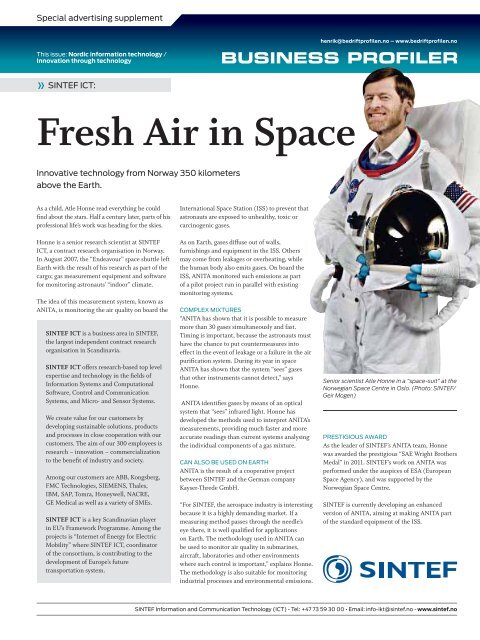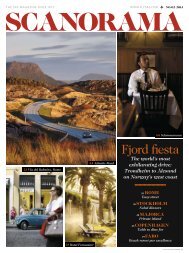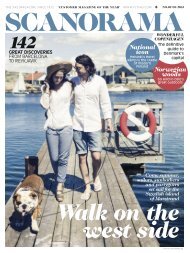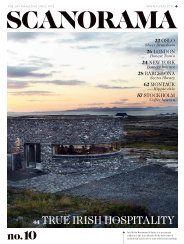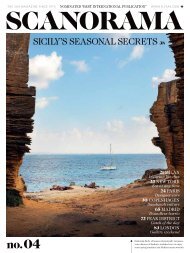Old school New England 92 - Scanorama
Old school New England 92 - Scanorama
Old school New England 92 - Scanorama
Create successful ePaper yourself
Turn your PDF publications into a flip-book with our unique Google optimized e-Paper software.
Special advertising supplement<br />
This issue: Nordic information technology /<br />
Innovation through technology<br />
» SINTEF ICT:<br />
Fresh Air in Space<br />
�������������������������������������������������<br />
����������������<br />
As a child, Atle Honne read everything he could<br />
find about the stars. Half a century later, parts of his<br />
professional life’s work was heading for the skies.<br />
Honne is a senior research scientist at SINTEF<br />
ICT, a contract research organisation in Norway.<br />
In August 2007, the “Endeavour” space shuttle left<br />
Earth with the result of his research as part of the<br />
cargo; gas measurement equipment and software<br />
for monitoring astronauts’ “indoor” climate.<br />
The idea of this measurement system, known as<br />
ANITA, is monitoring the air quality on board the<br />
SINTEF ICT is a business area in SINTEF,<br />
the largest independent contract research<br />
organisation in Scandinavia.<br />
SINTEF ICT offers research-based top level<br />
expertise and technology in the fields of<br />
Information Systems and Computational<br />
Software, Control and Communication<br />
Systems, and Micro- and Sensor Systems.<br />
We create value for our customers by<br />
developing sustainable solutions, products<br />
and processes in close cooperation with our<br />
customers. The aim of our 300 employees is<br />
research – innovation – commercialization<br />
to the benefit of industry and society.<br />
Among our customers are ABB, Kongsberg,<br />
FMC Technologies, SIEMENS, Thales,<br />
IBM, SAP, Tomra, Honeywell, NACRE,<br />
GE Medical as well as a variety of SMEs.<br />
SINTEF ICT is a key Scandinavian player<br />
in EU’s Framework Programme. Among the<br />
projects is “Internet of Energy for Electric<br />
Mobility” where SINTEF ICT, coordinator<br />
of the consortium, is contributing to the<br />
development of Europe’s future<br />
transportation system.<br />
International Space Station (ISS) to prevent that<br />
astronauts are exposed to unhealthy, toxic or<br />
carcinogenic gases.<br />
As on Earth, gases diffuse out of walls,<br />
furnishings and equipment in the ISS. Others<br />
may come from leakages or overheating, while<br />
the human body also emits gases. On board the<br />
ISS, ANITA monitored such emissions as part<br />
of a pilot project run in parallel with existing<br />
monitoring systems.<br />
COMPLEX MIXTURES<br />
“ANITA has shown that it is possible to measure<br />
more than 30 gases simultaneously and fast.<br />
Timing is important, because the astronauts must<br />
have the chance to put countermeasures into<br />
effect in the event of leakage or a failure in the air<br />
purification system. During its year in space<br />
ANITA has shown that the system “sees” gases<br />
that other instruments cannot detect,” says<br />
Honne.<br />
ANITA identifies gases by means of an optical<br />
system that “sees” infrared light. Honne has<br />
developed the methods used to interpret ANITA’s<br />
measurements, providing much faster and more<br />
accurate readings than current systems analysing<br />
the individual components of a gas mixture.<br />
CAN ALSO BE USED ON EARTH<br />
ANITA is the result of a cooperative project<br />
between SINTEF and the German company<br />
Kayser-Threde GmbH.<br />
“For SINTEF, the aerospace industry is interesting<br />
because it is a highly demanding market. If a<br />
measuring method passes through the needle’s<br />
eye there, it is well qualified for applications<br />
on Earth. The methodology used in ANITA can<br />
be used to monitor air quality in submarines,<br />
aircraft, laboratories and other environments<br />
where such control is important,” explains Honne.<br />
The methodology is also suitable for monitoring<br />
industrial processes and environmental emissions.<br />
henrik@bedriftprofilen.no – www.bedriftprofilen.no<br />
Senior scientist Atle Honne in a “space-suit” at the<br />
Norwegian Space Centre in Oslo. (Photo: SINTEF/<br />
Geir Mogen)<br />
PRESTIGIOUS AWARD<br />
As the leader of SINTEF’s ANITA team, Honne<br />
was awarded the prestigious “SAE Wright Brothers<br />
Medal” in 2011. SINTEF’s work on ANITA was<br />
performed under the auspices of ESA (European<br />
Space Agency), and was supported by the<br />
Norwegian Space Centre.<br />
SINTEF is currently developing an enhanced<br />
version of ANITA, aiming at making ANITA part<br />
of the standard equipment of the ISS.<br />
�����������������������������������������������������������������������������������������������������������www.sintef.no


